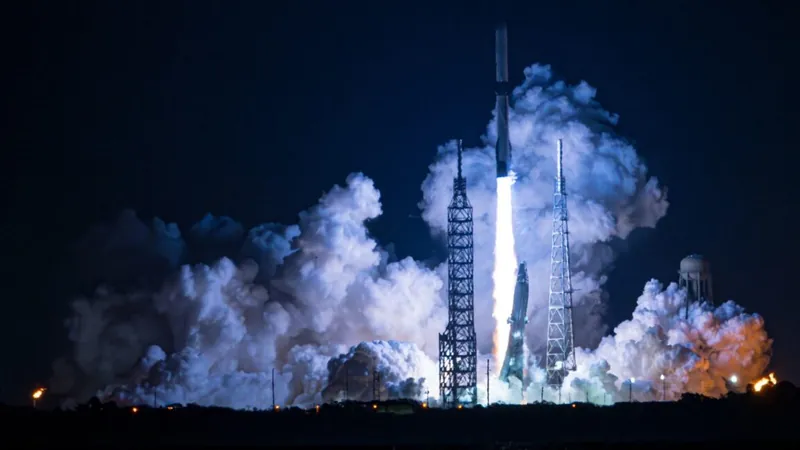
Dramatic Developments in Space Launches: Blue Origin Soars While Starship Faces a Setback
2025-01-17
Author: Wai
Introduction
The world of space exploration witnessed significant advancements and challenges recently, particularly with Blue Origin's New Glenn rocket achieving a highly anticipated successful launch and SpaceX's Starship undergoing an unexpected disassembly during its flight.
Blue Origin's Success
In the early hours of Thursday morning, Blue Origin marked a historic milestone as its New Glenn rocket took to the skies from Cape Canaveral Space Force Station in Florida. This launch was not just a test; it was a launch that marked a new era for Blue Origin, indicating the company’s potential resilience in the space market. Despite a slight delay due to technical issues with the BE-4 engines and a wayward boat in the launch path, the rocket successfully reached orbit. This triumph comes after years of development and numerous challenges, paving the way for future missions.
SpaceX's Starship Setback
In stark contrast, on Thursday afternoon, SpaceX's upgraded Starship rocket experienced a rapid unscheduled disassembly (RUD) shortly after taking off from South Texas. While the first stage performed well, the upper stage's failure raises questions about the rapid development approach SpaceX has undertaken with its flagship vehicle. The company has made headlines for its ambitious goals and aggressive timelines, and while it has achieved remarkable successes, this incident highlights the hurdles that remain.
European Space Initiatives
In the realm of European space initiatives, Rocket Factory Augsburg (RFA) has been granted a vertical launch license by the UK Civil Aviation Authority to conduct its inaugural flight of the RFA ONE rocket from SaxaVord Spaceport in Scotland. This licensing marks a significant milestone for the UK aerospace industry, signifying the first vertical launch license issued from British soil and igniting excitement for future rocket launches in the region.
China's Advancements
Meanwhile, China made strides with its space ambitions, successfully launching a Jielong-3 rocket from a mobile sea platform. The rocket deployed ten Centispace navigation enhancement satellites, showcasing China's capabilities in solid rocket propulsion and its expanding launch infrastructure.
Potential Spaceport in Utah
In the United States, discussions are underway in Utah regarding the potential establishment of a spaceport. State Senator Jerry Stevenson has proposed a bill to conduct a feasibility study on how such a site could bolster the state’s economy, particularly through tourism and scientific exploration. However, financial concerns linger, as critics express skepticism about the viability and return on investment for taxpayers.
Stoke Space's Funding and Plans
Stoke Space, a Washington-based company, recently announced it raised an impressive $260 million in Series C funding amidst a challenging financial environment for space startups. With plans to develop a fully reusable medium-lift rocket, Nova, Stoke aims to redefine launch economics in the industry.
Other Notable Developments
Other notable developments include Rocket Lab's preparation for the launch of its Neutron rocket, expected to debut later this year. This medium-lift vehicle intends to offer a competitive alternative to SpaceX's Falcon 9 by providing significant payload capacities at more attractive price points.
Additionally, SpaceX successfully deployed two commercial lunar landers using its Falcon 9 rocket, while ArianeGroup's Prometheus engine tests progressed successfully, reinforcing Europe’s position in the competitive space launch landscape.
Conclusion
As the space sector continues to rapidly evolve, the upcoming launches, including the next Falcon 9 missions scheduled for January, promise to keep the world engaged and eager for the next big leap in space exploration.
Stay tuned for more updates as the saga of space exploration unfolds—where success is celebrated, and setbacks are merely stepping stones!


 Brasil (PT)
Brasil (PT)
 Canada (EN)
Canada (EN)
 Chile (ES)
Chile (ES)
 Česko (CS)
Česko (CS)
 대한민국 (KO)
대한민국 (KO)
 España (ES)
España (ES)
 France (FR)
France (FR)
 Hong Kong (EN)
Hong Kong (EN)
 Italia (IT)
Italia (IT)
 日本 (JA)
日本 (JA)
 Magyarország (HU)
Magyarország (HU)
 Norge (NO)
Norge (NO)
 Polska (PL)
Polska (PL)
 Schweiz (DE)
Schweiz (DE)
 Singapore (EN)
Singapore (EN)
 Sverige (SV)
Sverige (SV)
 Suomi (FI)
Suomi (FI)
 Türkiye (TR)
Türkiye (TR)
 الإمارات العربية المتحدة (AR)
الإمارات العربية المتحدة (AR)